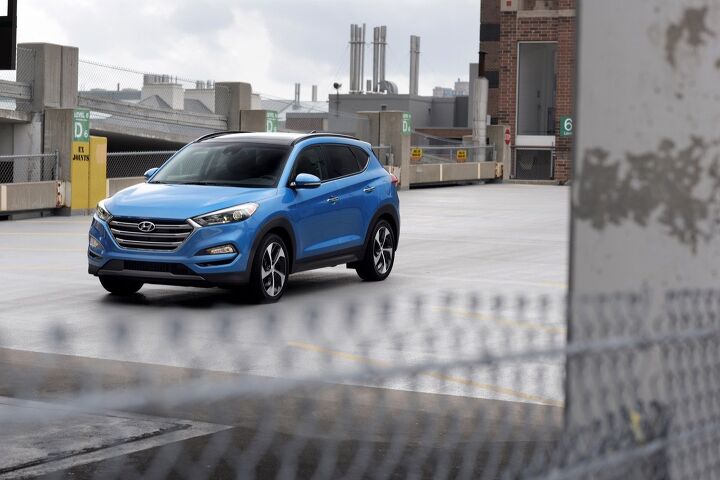The Tucson Is Hyundai's Current U.S. Success Story, but Inventory Problems Are Restricting That Success
Hyundai’s U.S. sales volume is down 13 percent through the first seven months of 2017, a year-over-year drop valued at 60,203 lost sales. Hyundai has fallen so quickly that its corporate partner, Kia, has managed to outsell Hyundai in America in each of the last three months.
But even with Hyundai sales falling nearly five times faster than the industry at large, and even with the two most popular products in the lineup — Elantra and Sonata — causing a 23-percent downturn in Hyundai passenger car sales, there’s good news to be heard out of Hyundai’s (shrinking) corner of the market.
The third-generation Tucson launched two years ago is a verifiable hit. Sales are perpetually rising. July 2017, in fact, was its best month ever.
But there’s bad news. Hyundai can’t get nearly enough Tucsons shipped across the Pacific from the compact crossover’s Ulsan, South Korea, assembly plant.
“We have the capacity to sell many more of those,” Hyundai Motor America’s vice president for planning tells Wards Auto. “Our biggest problem is not nearly enough of them. We’ve been suffering that since the very beginning.”
Hyundai’s U.S. dealers are obviously getting their hands on more Tucsons now than they were. Indeed, O’Brien says U.S. allocation has been increasing. But a vehicle such as the Tucson that’s routinely attracting more than 10,000 U.S. buyers per month would ideally have inventory of 25,000-30,000 copies in stock to maximize consumer selection and meet future demand. According to Cars.com, even with Tucson supply improving, there are fewer than 22,000 Tucsons in stock in the U.S.
Even in-demand vehicles suffer when selection is poor.
The Tucson nevertheless accounts for 16 percent of Hyundai’s year-to-date sales, up from 11 percent in the same period one year ago. Already, in only seven months, Hyundai has sold 62,964 copies of the Tucson, more than in any entire calendar year prior to this model’s launch. Hyundai is on track to sell 112,000 Tucsons in 2017 if the 25-percent rate of growth holds for the rest of the year. That’s more than double the number of Tucsons sold in America only three years ago.
Yet it could be better.
Hyundai remains cautious about the SUVs-Are-The-Answer theories of amateur automotive product planners. Hyundai is beginning to see similar levels of incentivization required to sell utility vehicles and cars, for example, while the general decline of the industry is going to increase competitiveness, an arena in which more utility vehicles will fall by the wayside.
The Tucson, however, appears to be in no danger. Hyundai’s smallest utility vehicle, at least until the Kona arrives next year with limited volume potential, is America’s 22nd-best-selling utility vehicle so far this year, ahead of the Jeep Renegade and Kia Sorento but behind the Honda Pilot and Dodge Journey.
[Image: Hyundai Motor America]
Timothy Cain is a contributing analyst at The Truth About Cars and Autofocus.ca and the founder and former editor of GoodCarBadCar.net. Follow on Twitter @timcaincars.
More by Timothy Cain
Latest Car Reviews
Read moreLatest Product Reviews
Read moreRecent Comments
- Lorenzo Yes, more sedans, but NOT "four-door coupes" with low, sloping rooflines. There's a market: The Malibu sold only 39,376 in 2021, but 115,467 in 2022, and130,342 last year. Surely GM can make money at that volume, even though it's the 4-D-C design. Auto executives need to pay less attention to stock price and more to the customers.
- 1995 SC The sad thing is GM tends to kill cars when they get them right, so this was probably a pretty good car
- Mason Had this identical car as a 17 year old in the late 90's. What a ball of fun, one of many I wish I still had.
- FinnEss At my age, sedans are difficult to get into without much neck and hip adjustment.I apologize sincerely but that is just the way it is. A truck is my ride of choice.Pronto
- Ajla The market for sedans is weaker than it once was but I think some of you are way overstating the situation and I disagree that the sales numbers show sedans are some niche thing that full line manufacturers should ignore. There are still a sizeable amount of sales. This isn't sports car volume. So far this year the Camry and Civic are selling in the top 10, with the Corolla in 11 and the Accord, Sentra, and Model 3 in the top 20. And sedan volume is off it's nadir from a few years ago with many showing decent growth over the last two years, growth that is outpacing utilities. Cancelling all sedans now seems more of an error than back when Ford did it.


































Comments
Join the conversation
I hope they make an N version of this with the 2.0T and DCT.
I own a 2017 Tucson with the 1.6T/DCT combo. It's a fine little CUV with lots of passenger room and is surprisingly fun to drive...at least when you can get the transmission to cooperate. Aside from supply problems, the DCT is this vehicle's Achilles heel. Lots of complaints on owner's boards about delayed or even no acceleration. From my experience, the claims are not without merit. While I've never experienced a "no-go" situation, I have seen plenty of stuttering in stop-and-go traffic, as well as inconsistent throttle response. A lawsuit alleging design defects in the transmission control module was filed on behalf of owners of the Tucson and other Hyundai vehicles with the DCT (Elantra, Sonata, Veloster). http://www.hyundaidctlawsuit.com/